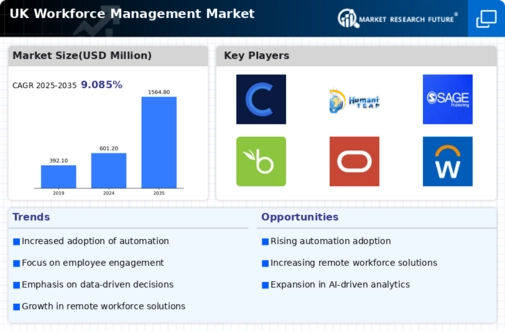Integration of Workforce Analytics
The integration of workforce analytics is emerging as a critical driver in the workforce management market. Organizations in the UK are increasingly leveraging data analytics to gain insights into employee performance, productivity, and engagement levels. By utilizing advanced analytics tools, businesses can make informed decisions regarding workforce planning and resource allocation. The workforce management market is projected to grow by 12% annually as companies recognize the value of data-driven insights in optimizing their operations. Furthermore, the ability to analyze workforce data allows organizations to identify trends, forecast future needs, and implement strategies that enhance overall efficiency. This analytical approach not only supports better decision-making but also fosters a culture of continuous improvement within the workforce.
Regulatory Compliance and Labor Laws
The workforce management market is significantly influenced by the evolving landscape of regulatory compliance and labor laws in the UK. With the introduction of stricter regulations regarding employee rights, working hours, and data protection, organizations are compelled to adopt comprehensive workforce management solutions. Compliance with the General Data Protection Regulation (GDPR) and the Employment Rights Act necessitates accurate record-keeping and reporting capabilities. As a result, businesses are increasingly investing in workforce management systems that ensure adherence to these regulations, thereby mitigating legal risks. The market is expected to see a growth rate of approximately 8% annually as companies prioritize compliance to avoid penalties and enhance their reputation. This focus on regulatory adherence not only safeguards organizations but also fosters a more transparent and equitable work environment.
Shift Towards Flexible Work Arrangements
The market is adapting to the growing trend of flexible work arrangements in the UK. As employees increasingly seek work-life balance, organizations are implementing hybrid and remote work models. This shift necessitates advanced workforce management solutions that can accommodate diverse scheduling needs and monitor employee performance effectively. According to recent studies, around 60% of UK workers prefer flexible working options, prompting businesses to rethink their workforce strategies. Consequently, the demand for tools that facilitate remote collaboration, time tracking, and performance evaluation is on the rise. The workforce management market is likely to expand as companies invest in technologies that support these flexible arrangements, ultimately leading to improved employee satisfaction and retention rates.
Focus on Employee Training and Development
The workforce management market is witnessing a heightened emphasis on employee training and development initiatives. Organizations in the UK are increasingly recognizing the importance of upskilling their workforce to remain competitive in a rapidly changing business environment. This focus on continuous learning is driving investments in workforce management solutions that incorporate training modules and performance tracking features. Research indicates that companies that prioritize employee development experience a 24% higher profit margin compared to those that do not. As a result, the workforce management market is expected to grow as businesses seek to implement comprehensive training programs that enhance employee capabilities and drive organizational success. This trend not only benefits the workforce but also contributes to a more skilled and adaptable labor market.
Technological Advancements in Workforce Management
The workforce management market is experiencing a notable shift due to rapid technological advancements. Innovations in software solutions, such as cloud-based platforms and mobile applications, are enhancing operational efficiency. In the UK, the market is projected to grow at a CAGR of 10.5% from 2025 to 2030, driven by the increasing demand for real-time data analytics and automated scheduling tools. These technologies enable businesses to optimize workforce allocation, reduce labor costs, and improve overall productivity. Furthermore, the integration of artificial intelligence and machine learning into workforce management systems is streamlining processes, allowing for more accurate forecasting and resource planning. As companies continue to invest in these technologies, the workforce management market is likely to expand, providing organizations with the tools necessary to adapt to changing workforce dynamics.


















Leave a Comment